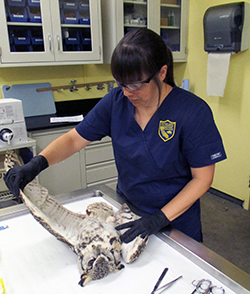Krysta Rogers is a senior environmental scientist at CDFW’s Wildlife Investigations Laboratory. She is the statewide lead for avian mortality investigations. Her professional experience has been focused almost exclusively on birds, including bird identification, biology, ecology and behavior. She has led and participated in numerous field projects including bird surveys, trapping, banding and sample collection.
Krysta earned both her Bachelors and Masters of Science degrees in Wildlife from Humboldt State University. She came to CDFW in 2007 as a wildlife biologist, starting out as the avian influenza surveillance coordinator. She subsequently worked on developing the lab’s Avian Investigations program, which includes mortality investigations, disease research and health surveillance for the many different bird species in California.
Who or what inspired you to become a scientist?
I had an interest in animals from a very young age and pursued this initially in the field of veterinary medicine. Although I enjoyed the animal health aspect, I learned I did not want to become a veterinarian in a small animal practice. I was unaware of other career possibilities until I took an elective course on endangered species at my local community college. The class introduced me to the career of wildlife biologist which subsequently informed my decision to attend Humboldt State University to obtain a degree in Wildlife. Later, while working toward my Master’s degree, my thesis advisor, Dr. Rick Botzler, taught me how to incorporate my interest in animal health into the study of wildlife biology.
What is a typical day like for you at work?

As the lead for avian mortality investigations, I spend most of my time responding to reports of dead birds from CDFW staff, other agencies, wildlife rehabilitation centers and the public. Given that most birds are active during the day and are thus highly visible to the public, these reports come in almost constantly. For investigations, I obtain carcasses for post-mortem exam to determine the cause of death, which may inform management actions. I either will perform the gross necropsy myself and submit various tissues for testing, or I will coordinate with another lab for the post-mortem exam and testing. Then I interpret the results and determine the next course of action. These investigations are varied – for instance, house finches and mourning doves dying from diseases at backyard bird feeders, juvenile California scrub jays and Cooper’s hawks dying of West Nile virus, Western and Clark’s grebes dying from starvation along the coast and at inland reservoirs, or bald and golden eagles dying of toxicosis or electrocution.
What is your favorite species to interact with or study?
It’s impossible to pick a single species; I’m interested in birds in general. There are more than 600 species of birds in California that live in a diversity of habitats. Different diseases or conditions can affect different species. This great diversity means always having the opportunity to learn something new in terms of species biology, a pathogen or environmental impacts.
What is it about the work you do that you find most interesting?
Investigating causes of mortality is almost like being a detective. You need to gather lots of detail and determine what factors are relevant to the cause of death for a particular animal. Sometimes this may be relatively easy with a pathogen or condition you routinely investigate, but sometimes it’s something entirely new. This aspect keeps the investigations interesting.
What is the most challenging part of your job?
One challenge is communicating the importance of incorporating animal health into resource management and conservation plans. For many avian species, we don’t have even a basic understanding of the impacts of diseases or contaminants that may influence population growth or decline. The lack of this information may limit our ability to manage species over the long-term, especially in the face of climate change. Climate change will almost certainly favor certain pathogens or host species that can aid in disease transmission.
What is the most rewarding project that you’ve worked on for CDFW?
So far, it’s been collaborating with researchers at the University of California, Davis to investigate avian trichomonosis in our native band-tailed pigeons. Avian trichomonosis is a disease caused by a protozoan parasite that in band-tailed pigeons causes near annual large-scale mortality events. This project enabled us to genetically characterize the parasites infecting band-tailed pigeons, including naming a new species of parasite, and evaluate the ecological drivers and the population impacts of these disease events on band-tailed pigeons, a migratory game species.
If you had free reign and unlimited funding, what scientific project would you most like to do?
I’d like to work towards an improved understanding of the impacts certain pathogens have on different avian species. This would include genetically characterizing the pathogens, identifying host range, and learning how avian species interact with their environment and the means by which they are exposed to certain pathogens.
Do you have any advice for people considering careers in science or natural resources?
Because there are so many career options in the field of science and natural resources, I’d recommend trying to get exposed to a diversity of people and projects as early as possible (e.g. junior high, high school). This can be accomplished through interviewing professionals, volunteering, internships and paid jobs. Learning about the different career options enables you to determine your interests and will help guide your educational path and eventually your career goals.